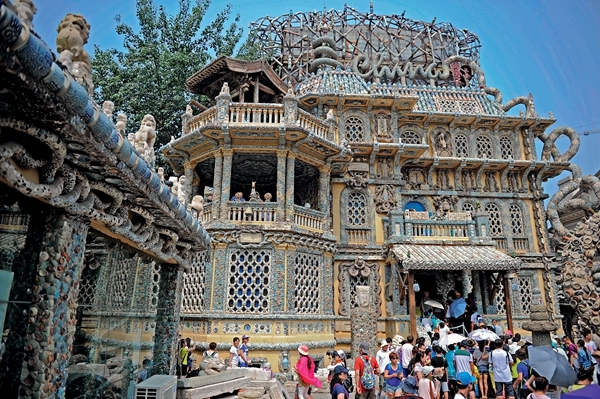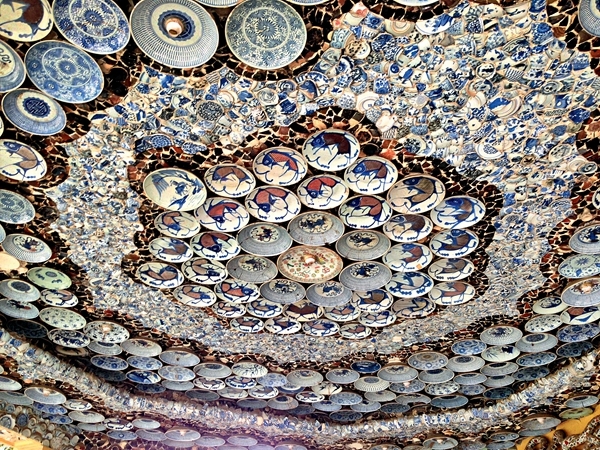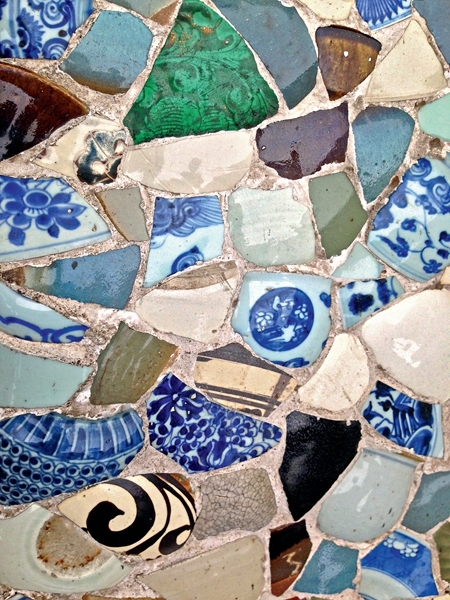All in the best possible taste?
- By Brian Salter
 0 Comment(s)
0 Comment(s) Print
Print E-mail China Today, April 25, 2017
E-mail China Today, April 25, 2017
They say that beauty lies in the eye of the beholder. What some people might consider as excessively ornate to the extent of kitsch can nevertheless often raise a smile or two. But surely no-one who passes the incomparable China House in the city of Tianjin, some 120 km southeast of Beijing, could fail to be intrigued, and wonder what its interior might be like.
China House (aka Porcelain House) is a "contemporary" museum of ceramics and antiques situated in a historical colonial building – No. 72, Chifeng Dao, in Heping District. The museum's richly wrought – some might say garish – exterior sets it apart from any other building you have ever seen.
|
|
|
Hardly a centimeter of the house exterior has been left untouched. |
I guess we are all curious at heart, and I succumbed to the urge to enter the extraordinary museum on my fourth visit to this lovely city.
The old five-story French-style house, which covers around 3,000 square meters, was originally the home of a late Qing Dynasty (1644-1911) central finance minister. After the founding of the People's Republic of China in 1949 it was converted into a bank. The building then remained unoccupied until September 2, 2002, when porcelain collector Zhang Lianzhi bought it for RMB 1 million (US $145,000). He spent the next four years converting the building – or work of art – into its present splendor.
Shock at First Sight
An estimated 5,000 ancient vases, 4,000 plates, and 400 million porcelain fragments adorn the building's exterior. No one could dispute its epithet, "the most eye-catching building in Tianjin." Since opening to the public in September 2007, it has of course become one of the city's most popular tourist attractions.
The courtyard wall is embedded with around 3,000 porcelain vases. The "peace" wall in front of the museum consists of 635 vases made during the late Qing Dynasty, and the Republic of China period (1911-1949).
|
|
|
One of the museum ceilings. |
In some ways the place is reminiscent of certain famous Gaudi buildings that grace Barcelona – guaranteed to shock at first glance but which soon enchant the beholder. The house itself is decorated with some 400 million fragments of ancient porcelain, 16,000 pieces of ancient chinaware, 300 white-marble carvings, 20 tons of crystal and agate, and millions of ancient Chinese ceramic chips. Some of the vases and fragments are from as long ago as the Tang Dynasty (618-907).
In fact, about 80 percent of the porcelain embellishing the building is from broken or damaged antiques. Zhang mixed the various fragments and pasted them on the walls in such a way as to conceal their damaged parts. Consequently most of them appear to be intact.
Zhang ensured that elements of Chinese "culture" took center stage in the museum's exterior décor. He took particular care to feature several groups of entwined dragons on the exterior wall, each one more than 200 meters long and pieced together from thousands of porcelain pieces. Dragons are believed to symbolize the power of ancient China, and are a dominant feature of Chinese architecture.
Everyone snaps away on their mobile phones and takes striking selfies like there was no tomorrow. The museum interior, however, is dim. This impedes full appreciation of the inventive use of a broken teacup.
The museum also contains an abundance of antique furniture, arranged as if for a junk yard sale. The subdued lighting makes it difficult to discern whether these are good pieces or just junk. My guess would be the latter.
|
|
|
Porcelain fragments put to good use. |
There are some choice items, however. They include porcelain mosaics of different animals, sceneries, and Chinese characters. The mosaic eagle is a truly handsome bird, while the snub-nosed tiger is somehow engaging, if perhaps a little anatomically challenged!
I must say that some of the ceiling designs, too, have been excellently executed.
Zhang Lianzhi, meanwhile, insists that it has all been done in the best possible taste. "The design is based on my understanding of antique porcelain and traditional Chinese culture," he once explained. "The experience is like a child building his dream house with toy bricks. With such a large amount of porcelain pieces, all I needed was my imagination to create and explore."
Many would argue that used in this way, these antique artifacts are now worthless. Zhang retorts that antiques are not things that can be conserved only in storage houses. To his mind he is giving his collection a new lease of life by presenting them to the public. "I want to share my enthusiasm for the collection with many more people. For the past 20 years, I have taken great enjoyment in studying the stories and history behind these ceramics. It would be both a pity and a waste if the joy of all these fabulous works of art were to be confined solely to me."
If you are wondering how Zhang could afford to compile such a museum, it turns out that he was born to a wealthy Tianjin family, and also owns a profitable Cantonese-style restaurant chain. Having been a collector of antique porcelain for well over 20 years, perhaps he just ran out of space in which to store it all.
One of his latest acquisitions is a fully functional Land Rover covered with approximately 10,000 pieces of antique ceramics. It has an estimated worth of around RMB 1 million. Although its owner is reluctant to put a price tag on China House, certain "experts" have evaluated the museum's worth as at least RMB 2 billion.
The U.S. Huffington Post has listed China House as one of the world's 15 most stunning museums. Rumors even abound that Bill Gates wanted to buy it, but was refused.
This all goes to show, I suppose, that there is no single definition of good taste, and that beauty really does lie in the eye of the beholder.
BRIAN SALTER is a broadcaster and journalist who has been working in China for the past five years.








